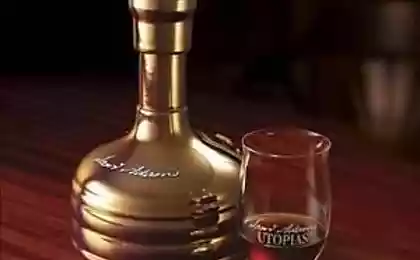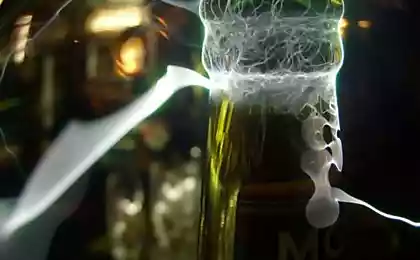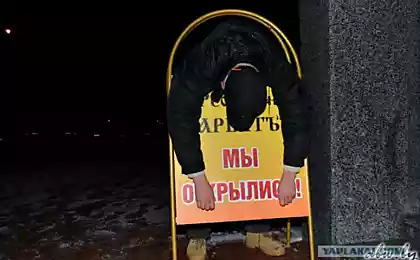521
Beer is not only harmful but also useful
5 Picchu
Spied on popular mechanics
Chemical analysis of bones from the graves drevnenubiyskih surprised scientists: found that members of this lost civilization used antibiotics. Most likely, the source of those years could be just ... beer.

It really amazes: officially launched the era of antibiotic use in 1928, with the discovery of penicillin - perhaps one of the most important events in the history of medicine. It turns out also that, even though unconsciously, the humanity used these substances have a few thousand years before that.
To such conclusion the group of American researchers led by anthropologist George Ermelagosom (George Armelagos) and chemist Mark Nelson (Mark Nelson). Ermelagos says: "Treating substance antibiotics - usually We attribute all of this only with modern medicine. But today, it is increasingly clear that even prehistoric civilizations have used empirical approach to find effective therapeutic compounds. Personally, I have no doubt they understand why and what to use ».
Back in the 1980s a team Ermelagosa, examining samples of bone from drevnenubiyskih graves discovered in them traces of tetracycline - despite the fact that discovery dates back 350-550 years. BC. and refers to a society, in our opinion, fairly primitive and did not leave in itself is no written evidence.
Subsequently, scientists have suggested that the source of the antibiotic to the Nubians of the era could serve beer. The fact that the grains used for their fermentation and brewing beverages containing soil bacterium streptomycetes producing tetracycline. By modern standards, it was the pollution - but the pollution is extremely useful.
Intrigued by the work Ermelagosa, connected to it, and Mark Nelson, an acknowledged expert in the field of antibiotics. Taking samples of bone from the collection of anthropologists, he in the complex (and quite dangerous, involves the dissolution of an extremely toxic hydrofluoric acid) process confirmed the presence of tetracycline. Nelson is just amazed, "Bone ancient people kept so many antibiotics - he says - that they obviously got it in for a very long time. As if they had modern, diversified chemical industry and biological production ».
Interestingly, that tetracycline and showed up in the tibia and skull, identified as the remains of a 4-year old child. This suggests that - or the Nubians began drinking beer already at this tender age, the child or give it to a specific therapeutic purposes.
Coming back to our days, adding that the tetracycline was opened in 1948 and was initially aureomycin name, from the Latin aureos, ie "Gold" - because of the gold, which become producing its colony of bacteria Streptomyces,. Perhaps it was this color foam on a beer cap initially estimated the ancient people, and only then notice and therapeutic properties.

Fluorescent sample area on the skeleton of the ancient Nubian show deposits of tetracycline

Analysis: After processing and dissolution of bone tetracycline yellow film deposited on the wall of the flask

Ancient statues since the 12th dynasty: the workers pounded, boiled and fermented corn. Nubian kingdom was located in the south of Ancient Egypt, in the territory of modern Sudan

Source:
Spied on popular mechanics
Chemical analysis of bones from the graves drevnenubiyskih surprised scientists: found that members of this lost civilization used antibiotics. Most likely, the source of those years could be just ... beer.

It really amazes: officially launched the era of antibiotic use in 1928, with the discovery of penicillin - perhaps one of the most important events in the history of medicine. It turns out also that, even though unconsciously, the humanity used these substances have a few thousand years before that.
To such conclusion the group of American researchers led by anthropologist George Ermelagosom (George Armelagos) and chemist Mark Nelson (Mark Nelson). Ermelagos says: "Treating substance antibiotics - usually We attribute all of this only with modern medicine. But today, it is increasingly clear that even prehistoric civilizations have used empirical approach to find effective therapeutic compounds. Personally, I have no doubt they understand why and what to use ».
Back in the 1980s a team Ermelagosa, examining samples of bone from drevnenubiyskih graves discovered in them traces of tetracycline - despite the fact that discovery dates back 350-550 years. BC. and refers to a society, in our opinion, fairly primitive and did not leave in itself is no written evidence.
Subsequently, scientists have suggested that the source of the antibiotic to the Nubians of the era could serve beer. The fact that the grains used for their fermentation and brewing beverages containing soil bacterium streptomycetes producing tetracycline. By modern standards, it was the pollution - but the pollution is extremely useful.
Intrigued by the work Ermelagosa, connected to it, and Mark Nelson, an acknowledged expert in the field of antibiotics. Taking samples of bone from the collection of anthropologists, he in the complex (and quite dangerous, involves the dissolution of an extremely toxic hydrofluoric acid) process confirmed the presence of tetracycline. Nelson is just amazed, "Bone ancient people kept so many antibiotics - he says - that they obviously got it in for a very long time. As if they had modern, diversified chemical industry and biological production ».
Interestingly, that tetracycline and showed up in the tibia and skull, identified as the remains of a 4-year old child. This suggests that - or the Nubians began drinking beer already at this tender age, the child or give it to a specific therapeutic purposes.
Coming back to our days, adding that the tetracycline was opened in 1948 and was initially aureomycin name, from the Latin aureos, ie "Gold" - because of the gold, which become producing its colony of bacteria Streptomyces,. Perhaps it was this color foam on a beer cap initially estimated the ancient people, and only then notice and therapeutic properties.

Fluorescent sample area on the skeleton of the ancient Nubian show deposits of tetracycline

Analysis: After processing and dissolution of bone tetracycline yellow film deposited on the wall of the flask

Ancient statues since the 12th dynasty: the workers pounded, boiled and fermented corn. Nubian kingdom was located in the south of Ancient Egypt, in the territory of modern Sudan

Source:
























